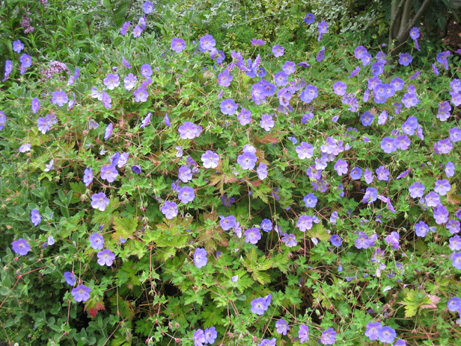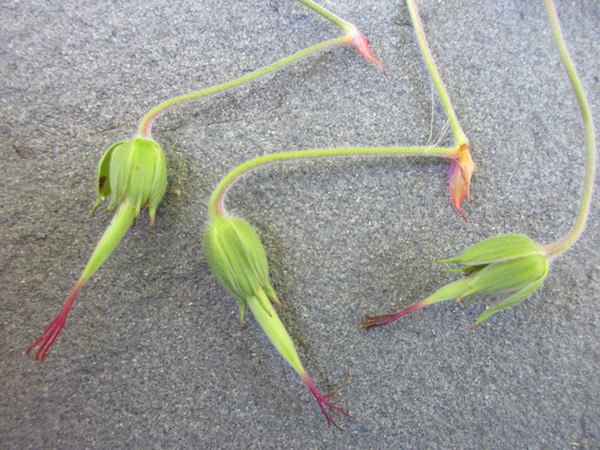Perennial garden flowers that bloom tirelessly for many months instead of offering merely a week or two of glory, please us mightily --they give us so much more color. In the same way that we prefer our batteries to last longer and be rechargeable, as opposed to being short-lasting and non-rechargeable. Or prefer long-lasting relationships to a series of short ones.
|
| In my experience, most of the longest blooming perennials prized in gardens either reseed weedily, or must have their spent flowers plucked or cut off (dead-headed) in order to stay productive and lovely. A long-blooming re-seeder I encourage is Erigeron Karvinskianus, called variously the Santa Barbara Daisy, Mexican Daisy and Mexican Fleabane. Long-blooming perennials that need dead-heading to stay at their best include various Salvia and Penstemon hybrids |
Disregarding shrubs such as Fuchsia, Grevillea Victoriae, Phygelius, and Solanum crispum 'Glasnevin', the garden flowers that bloom the longest in Seattle without reseeding or needing to be dead-headed, are Geranium RozanneTM ('Gerwat') and Geranium 'Jolly Bee'.
|
| Over the decades I have tended the following dozen Geranium species and hybrids: |
| Geranium x cantabrigiense 'Biokovo' |
| Geranium 'Johnson's Blue' |
| Geranium macrorrhizum 'Album' |
| Geranium macrorrhizum 'Ingwersen's Variety' |
| Geranium x oxonianum 'A.T. Johnson' |
| Geranium x oxonianum 'Bressingham Delight' |
| Geranium x oxonianum 'Claridge Druce' |
| Geranium x oxonianum 'Phœbe Noble' |
| Geranium pratense |
| Geranium Renardii |
| Geranium sanguineum |
Geranium sanguineum var. striatum (lancastriense)
|
| But there are so many others! A 2004 book, The Plant Locator® Western Region, lists 430 different kinds of Geranium for sale in the western U.S. and Canada. So I admit freely that it may be there are other Geranium cultivars that are as impressively long blooming as RozanneTM and 'Jolly Bee'. The California nursery Geraniaceae may offer some: www.geraniaceae.com. |
| RozanneTM (Rosanne) (official cultivar name 'Gerwat') is a hybrid Geranium that originated before 1990 in the garden of Rozanne Waterer in Somerset, England. The plant was given to Adrian Bloom of Blooms of Bressingham in 1992 for commercial development. It was released to the public for the 2000-2001 gardening seasons. |
| RozanneTM appears to be a chance hybrid of G. himalayense and G. Wallichianum 'Buxton's Variety.' Both species are native to the Himalaya Mountain region, though G. himalayense blooms in spring, while G. Wallichianum blooms in summer and fall. |
| The 1.25 to 2.5 inch wide flowers of RozanneTM are violet-blue with pale centers. RozanneTM grows in full sun or part shade. I have not seen it growing in Seattle without summer watering. |
| In contrast, 'Jolly Bee' is newer than RozanneTM, and was an intentional hybrid from Warmond, The Netherlands. The female (seed) parent was Geranium shikokianum var. yoshiianum; the male or pollen parent was G. Wallichianum 'Buxton's Variety'. The offspring cultivar 'Jolly Bee' was selected in 1998. It received U.S. Plant Patent #12,148 in 2001, and was being sold by 2003. 'Jolly Bee' greatly resembles RozanneTM but some people insist it is more compact and vigorous, with a clearer blue flower. (In April 2010, a statement released by Blooms of Bressingham NA said: "Independent DNA research revealed that there are virtually no differences in the DNA of both varieties. In addition, new investigations revealed that both varieties are not, at least not clearly, distinct from one another from a morphological point of view.
Blooms of Bressingham NA recently informed Marco Van Noort about these test results and requested that Van Noort cease and desist the exploitation of 'Jolly Bee' no later than July 1st.") |
| In May 2004 in the same Seattle garden, same soil and same irrigation system, I planted both 'Jolly Bee' and RozanneTM. Over the last four summers I have observed them bloom. To me that they are virtually identical. The RozanneTM I planted near a Cistus shrub, on which it supports its stems. At present the RozanneTM is 6.5 feet wide in one direction, 6 feet in another, and 2.5 feet high. The 'Jolly Bee' is in a less sunny site, in a Persicaria 'Red Dragon', and measures 7.5 feet by 6 feet by 3 feet high. Both cultivars bloom from May until frost in November. The flowers vary from about 1.25 to 1.75 (2.5) inches wide. They require zero dead-heading and ripen no viable seeds as far as I can see, and very few unripe fruits are made (as in my photo). They are roundly admired by all visitors who see their unstinting floral abundance. |
Though in my own garden I will not plant perennials that are merely beautiful, requiring in addition fragrance or edibility, I would almost make an exception for one of these two Geranium hybrids.
But as long as I advise other people what to plant in their gardens, I will no more suggest relatively inferior plants such as the much celebrated Geranium 'Johnson's Blue'. Until and unless I learn about other Geranium selections that can match 'Jolly Bee' and RozanneTM I will promote this pair. . . (In 2011, it was suggested to me that my RozanneTM was really a mislabeled 'Jolly Bee; that the two clones are in fact different but all mixed up commercially.)
Back
|

Geranium Rozanne photo by ALJ |

Geranium Jolly Bee photo by ALJ |

Geranium Jolly Bee unripe seedpods photo by ALJ |

